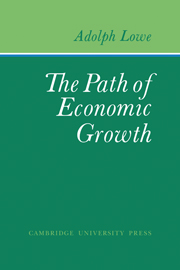Book contents
- Frontmatter
- Contents
- Preface
- Acknowledgments
- PART I The Basic Model
- PART II Changes in the Rate of Change
- 11 The Setting of the Problem
- 12 A Bird's-Eye View of an Expanding Traverse
- 13 On the Short-Period Variability of the Capital–Labor Ratio
- 14 Adjustment to a Higher Rate of Growth of Labor Supply in a Free Market. I. Structure Analysis
- 15 Adjustment to a Higher Rate of Growth of Labor Supply in a Free Market. II. Force Analysis
- 16 Adjustment to a Higher Rate of Growth of Labor Supply in a Collectivist System
- 17 Some Comments on the Role of Working Capital in the Traverse
- 18 Instrumental Analysis of Decline in the Rate of Growth of Labor Supply
- PART III Changes in the Rate of Change
- PART IV Changes in the Rate of Change
- Appendix: An Alternative Presentation of Lowe's Basic Model
- Glossary of Recurring Symbols
- Name Index
- Subject Index
12 - A Bird's-Eye View of an Expanding Traverse
Published online by Cambridge University Press: 07 October 2011
- Frontmatter
- Contents
- Preface
- Acknowledgments
- PART I The Basic Model
- PART II Changes in the Rate of Change
- 11 The Setting of the Problem
- 12 A Bird's-Eye View of an Expanding Traverse
- 13 On the Short-Period Variability of the Capital–Labor Ratio
- 14 Adjustment to a Higher Rate of Growth of Labor Supply in a Free Market. I. Structure Analysis
- 15 Adjustment to a Higher Rate of Growth of Labor Supply in a Free Market. II. Force Analysis
- 16 Adjustment to a Higher Rate of Growth of Labor Supply in a Collectivist System
- 17 Some Comments on the Role of Working Capital in the Traverse
- 18 Instrumental Analysis of Decline in the Rate of Growth of Labor Supply
- PART III Changes in the Rate of Change
- PART IV Changes in the Rate of Change
- Appendix: An Alternative Presentation of Lowe's Basic Model
- Glossary of Recurring Symbols
- Name Index
- Subject Index
Summary
The chapters to follow display a somewhat technical character, describing in symbolic terms the adjustment path from a given level of dynamic equilibrium to a higher or lower level and, in particular, the expansion, contraction, and relative shifts of the sectors of production. Although the mathematics is quite elementary and the results obtained in most cases confirm our intuitive hunches, it may be helpful to introduce these exercises by a literary survey of the strategic processes. We shall confine ourselves here to surveying the consequences of an increase in the rate of labor supply. Knowing that in all such instances it is the formation of real capital that is at the center, we shall first consider the formation and application of additional fixed capital, to be followed by inspection of the changes in working capital.
The traverse movements affecting fixed capital, which serve to absorb an increase in the rate of labor supply, can be subdivided into four phases: partial liberation of existing capacity; augmentation of primary equipment output; augmentation of secondary equipment output; and augmentation of consumer goods output. We shall now explain the rationale for this sequence of movements and briefly describe the main characteristics of each phase.
1. Partial Liberation of Existing Capacity. On intuitive grounds the most appropriate place for the absorption of an increase in the labor increment seems to be the consumer-good sector.
- Type
- Chapter
- Information
- The Path of Economic Growth , pp. 109 - 114Publisher: Cambridge University PressPrint publication year: 1976



